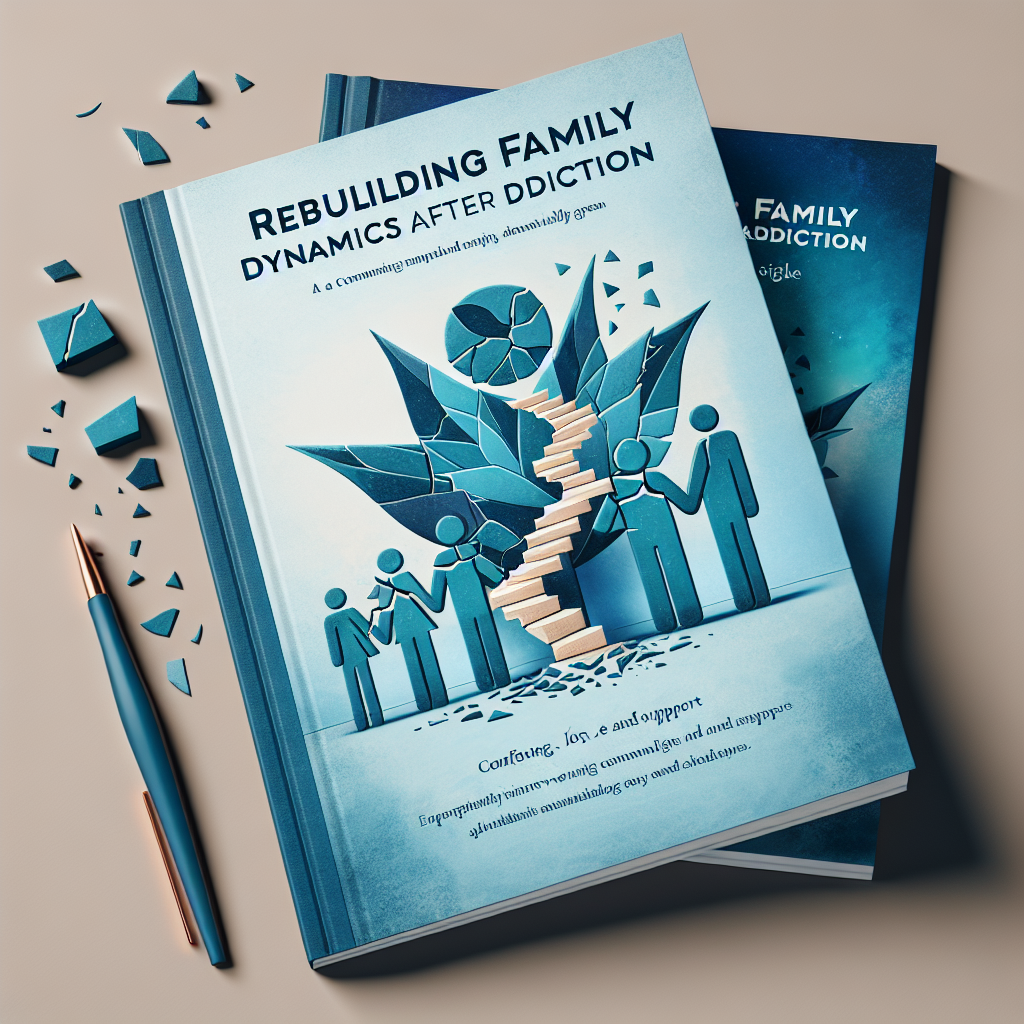-
Table of Contents

“Rebuilding Family Dynamics After Addiction: A Step-by-Step Guide – Healing Together, One Step at a Time.”
Introduction
“Rebuilding Family Dynamics After Addiction: A Step-by-Step Guide” is a comprehensive resource designed to help families navigate the complex and often challenging process of healing and restoring relationships after the impact of addiction. This guide delves into the emotional, psychological, and practical aspects of recovery, offering actionable steps and strategies to rebuild trust, improve communication, and foster a supportive environment. By addressing the unique needs of each family member and providing tools for conflict resolution and mutual understanding, this guide aims to facilitate a healthier, more resilient family dynamic, paving the way for long-term recovery and harmony.
Rebuilding Trust and Communication in Families Affected by Addiction
Rebuilding trust and communication in families affected by addiction is a delicate and multifaceted process, but it is also a journey filled with hope and the potential for profound healing. When addiction infiltrates a family, it often leaves a trail of broken trust, strained relationships, and emotional scars. However, with commitment, patience, and the right strategies, families can mend these fractures and emerge stronger than ever.
The first step in rebuilding trust is acknowledging the pain and damage caused by addiction. This requires open and honest communication, where each family member has the opportunity to express their feelings without fear of judgment or retaliation. It is essential to create a safe space where everyone feels heard and validated. This can be facilitated through family therapy sessions, where a neutral third party can guide the conversation and help navigate the complex emotions involved.
As families begin to communicate more openly, it is crucial to establish clear and consistent boundaries. Boundaries serve as a framework for rebuilding trust, as they define acceptable behaviors and set expectations for all family members. These boundaries should be mutually agreed upon and respected by everyone involved. For instance, if a family member in recovery commits to attending regular support group meetings, it is important for the rest of the family to support this commitment and hold them accountable.
In addition to setting boundaries, rebuilding trust also involves demonstrating reliability and consistency over time. Trust is not rebuilt overnight; it requires a series of positive actions that reinforce the commitment to change. This might include adhering to a treatment plan, being honest about one’s struggles, and making amends for past wrongs. Each small step forward helps to rebuild the foundation of trust that addiction may have eroded.
While trust is being rebuilt, it is equally important to focus on improving communication skills. Effective communication involves not only speaking but also listening actively and empathetically. Families can practice active listening by giving their full attention to the speaker, acknowledging their feelings, and responding thoughtfully. This fosters a deeper understanding and connection between family members, which is essential for healing.
Moreover, families should strive to communicate with compassion and empathy. Addiction often brings feelings of guilt, shame, and resentment, which can hinder open dialogue. By approaching conversations with empathy, family members can better understand each other’s perspectives and offer support rather than criticism. This compassionate approach helps to break down barriers and encourages a more open and honest exchange of thoughts and feelings.
As families work on rebuilding trust and communication, it is important to celebrate progress, no matter how small. Recognizing and acknowledging the positive changes can boost morale and reinforce the commitment to recovery. Celebrations can be as simple as verbal affirmations or as elaborate as family outings or special dinners. These moments of joy and connection serve as reminders of the progress made and the potential for a brighter future.
In conclusion, rebuilding trust and communication in families affected by addiction is a challenging yet rewarding journey. It requires a combination of honest dialogue, clear boundaries, consistent actions, and empathetic communication. By taking these steps, families can heal the wounds of addiction and build stronger, more resilient relationships. The path to recovery is not linear, but with perseverance and mutual support, families can overcome the shadows of addiction and move towards a future filled with hope and unity.
Strategies for Healing and Strengthening Family Bonds Post-Addiction Recovery
Rebuilding family dynamics after addiction is a journey that requires patience, understanding, and a commitment to healing. The process of recovery is not just about the individual who struggled with addiction; it also involves the entire family unit. As families navigate this challenging path, there are several strategies that can help heal and strengthen bonds, fostering a supportive and loving environment.
First and foremost, open communication is essential. Addiction often breeds secrecy and mistrust, which can erode family relationships. By encouraging honest and open dialogue, family members can begin to rebuild trust. This means creating a safe space where everyone feels heard and respected. Active listening, where each person genuinely tries to understand the other’s perspective, can be incredibly powerful. It’s important to remember that rebuilding trust takes time, and patience is key.
In addition to communication, setting healthy boundaries is crucial. During the period of addiction, boundaries may have been blurred or ignored. Re-establishing these boundaries helps create a sense of security and respect within the family. This might involve setting clear expectations about behavior, responsibilities, and the ways in which family members interact with one another. Boundaries are not about punishment; they are about creating a healthy environment where everyone can thrive.
Another vital strategy is seeking professional help. Family therapy can provide a structured and supportive setting for addressing deep-seated issues and fostering healing. A trained therapist can guide families through difficult conversations, help them develop coping strategies, and offer tools for rebuilding relationships. Therapy can also provide a neutral ground where each family member can express their feelings without fear of judgment.
Moreover, education plays a significant role in the healing process. Understanding addiction as a disease rather than a moral failing can shift the family’s perspective and reduce feelings of blame and shame. Learning about the nature of addiction, its impact on the brain, and the challenges of recovery can foster empathy and support. Many communities offer educational programs and support groups for families affected by addiction, providing valuable resources and a sense of solidarity.
Forgiveness is another cornerstone of rebuilding family dynamics. Holding onto past grievances can hinder the healing process. While forgiveness does not mean forgetting or excusing harmful behavior, it does involve letting go of resentment and moving forward. This can be a difficult and gradual process, but it is essential for emotional healing. Both the person in recovery and their family members may need to seek forgiveness and offer it in return.
Furthermore, focusing on positive activities and shared experiences can help strengthen family bonds. Engaging in activities that everyone enjoys can create new, positive memories and reinforce the sense of togetherness. Whether it’s a family game night, a hike in nature, or simply cooking a meal together, these moments of connection can be incredibly healing.
Lastly, it’s important to celebrate progress, no matter how small. Recovery is a long and often arduous journey, and acknowledging milestones can provide motivation and hope. Celebrating achievements, whether it’s a month of sobriety or a successful family outing, reinforces the progress made and the strength of the family unit.
In conclusion, rebuilding family dynamics after addiction is a multifaceted process that involves open communication, setting healthy boundaries, seeking professional help, educating oneself, practicing forgiveness, engaging in positive activities, and celebrating progress. By embracing these strategies, families can heal and emerge stronger, creating a supportive and loving environment that fosters long-term recovery and well-being.
Q&A
1. **Question:** What are some initial steps to rebuild trust within a family after a member has struggled with addiction?
**Answer:** Initial steps to rebuild trust include open and honest communication, setting and respecting boundaries, seeking family therapy, and demonstrating consistent, reliable behavior over time.
2. **Question:** How can family members support a loved one in recovery while also taking care of their own well-being?
**Answer:** Family members can support a loved one in recovery by educating themselves about addiction, attending support groups like Al-Anon, setting healthy boundaries, practicing self-care, and seeking individual therapy if needed.
Conclusion
Rebuilding family dynamics after addiction requires a structured approach that includes open communication, professional therapy, setting healthy boundaries, and fostering mutual support. By addressing underlying issues, rebuilding trust, and creating a supportive environment, families can heal and strengthen their relationships, ultimately leading to a healthier and more cohesive family unit.



